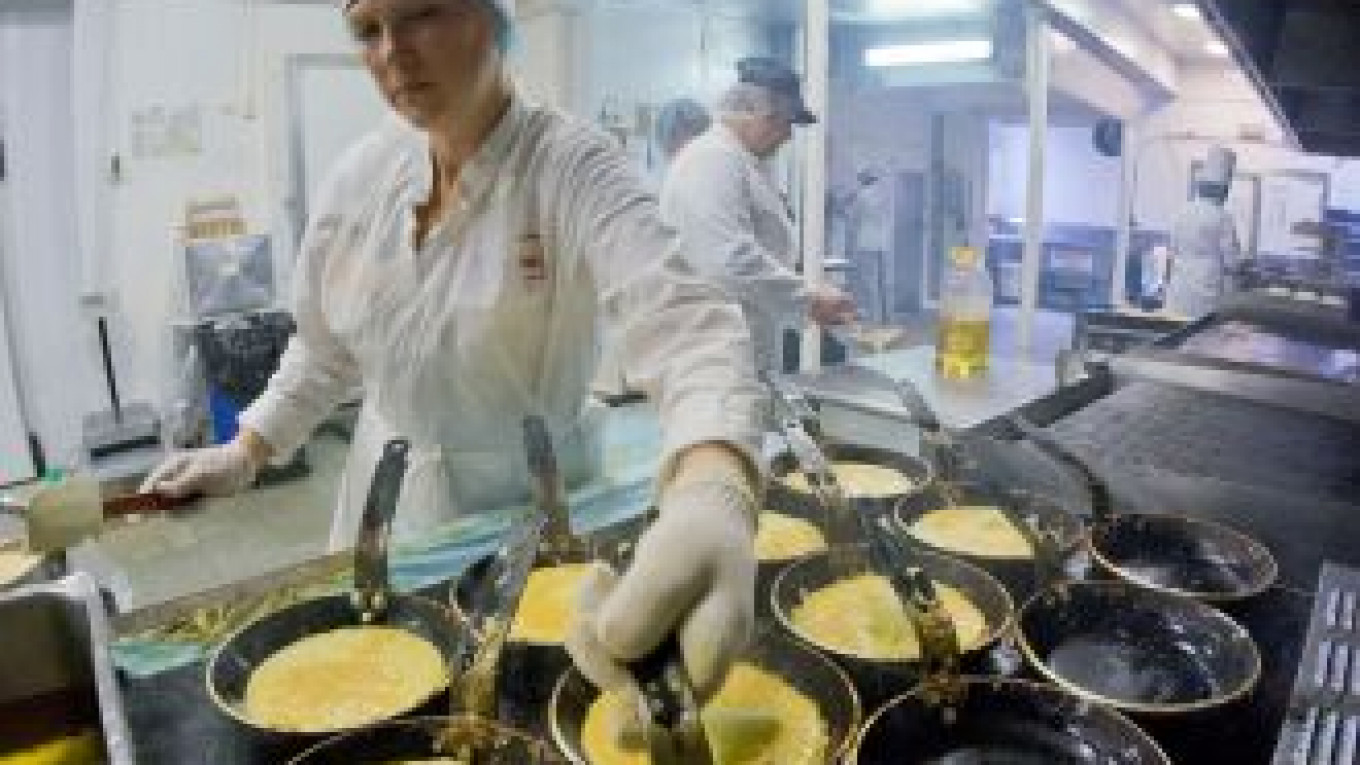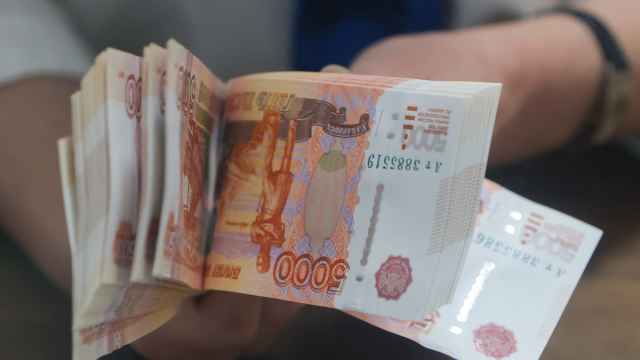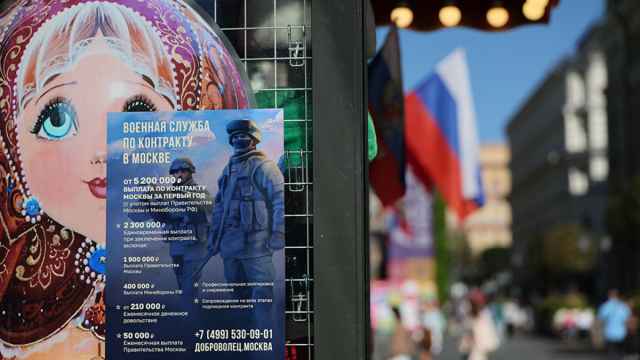KHIMKI, Moscow region — Departing from Moscow after her first trip to Russia in 1994, Britain's Queen Elizabeth II asked for lamb sandwiches to be served on board her plane — a request that challenged the local caterer in charge of supplying meals for the flight.
As a result of a scarce supply of high-quality food products following the breakup of the Soviet Union, such meat was hard to find, and Aeromar, an airline catering company based at Sheremetyevo Airport, had to buy lamb specially for the VIP flight.
"We were told that the queen prefers lamb, as it's the healthiest meat," said Irina Ivanyuzhenkova, the company's manufacturing director.
Unlike the British monarch, Russian leaders appear to be less fussy about their in-flight meals, with traditional Russian cuisine being the most frequent choice for both President Vladimir Putin and Prime Minister Dmitry Medvedev.
"They don't have any special preferences: Russian cuisine; everything is modest," said Anatoly Olkhovsky, chief executive of the Restaurant Vnukovo firm, which has food preparation facilities for airline catering and a chain of bars, cafes and restaurants serving passengers flying from Vnukovo International Airport.
Putin, known for his healthy lifestyle, also likes dairy products and often enjoys yogurt during the flight, said Olkhovsky, whose company makes meals for the flights from the terminal at Vnukovo serving official delegations.
Attention And Volume
Airline catering in Russia has faced drastic changes since the visit of the British queen. Roasted lamb is now a common dish served in economy class, along with chicken, omelets and pancakes, all made by caterers at the three Moscow airports.
The dishes for the flights from Sheremetyevo are cooked at Aeromar, a small facility 11 kilometers northwest of Moscow that seduces passing motorists with the delicate aroma of cinnamon wafting from its oven exhaust fans.
When a reporter visited Aeromar in late September, work was humming in one of its preparation sections, with clouds of steam rising from long black stoves. This is where hot dishes are prepared for onboard meals.
A lady dressed in a white robe and a high, white toque draped down to her eyebrows was frying dozens of thin pancakes forming perfect rows on the stove. A nearby device was occupied by a dozen frying pans. A chef was adroitly wrapping the edges of omelets to make equal triangles, while a colleague across from her used a long metal paddle to stir chicken ragout boiling in a 100-liter tub.
Cooking big volumes of food is most challenging in airline catering, said Aeromar executive chef Harald Sjostrom.
"A restaurant chef cooking, let's say, a seafood sauce, has a chance to try it to understand whether some more salt or what else needs to be added. It's impossible when you cook 15 liters of sauce," he said, smiling.
For that reason, the cooking process at the factory is strictly regulated. Chefs are provided with dispatch lists outlining how much of each ingredient is needed to make the required number of portions for a flight. Following those instructions, a chef then mixes the ingredients and oversees the cooking process.
To make 71.2 kilograms of vegetarian frittata, for example, a chef must take 9.2 kilograms of tomato cubes, according to one dispatch list at Aeromar.
To supply the carriers' daily needs, the caterer uses dozens of tons of various products every day, including 3 tons of leaf salad, 1 ton of fish and beef, about 1 ton of light, salty fish, 300 kilograms of fresh cucumbers and an equal amount of fresh tomatoes, Ivanyuzhenkova said.
About 80 percent of meals produced by Aeromar, a joint venture of Aeroflot and Lufthansa caterer LSG Sky Chefs, are supplied to Aeroflot flights, with the remaining going to the likes of Air France, KLM and Delta Air Lines, which fly from Sheremetyevo Airport.
The facility, which has about 500 employees, works around the clock to ensure a constant supply of in-flight meals.
Building Menus
Before getting on passengers' plates, every dish or snack undergoes a sampling process. Aeromar chief executive Vladimir Dzhao, who tries all the meals himself, is the most demanding critic.
Degustation samples for Aeroflot economy class in September, a few days before the planned change of the carrier's in-flight-menu, included Bhuna chicken with rice and vegetables; beef ragout with mashed potatoes and green beans; fried tilapia in oyster sauce with rice, broccoli and carrot; roasted lamb with Chinese noodles; fried humpback salmon with spinach and orzo noodles; and stewed beef stripes in oyster sauce with pasta.
Menus change every six months for economy class and every three months for business class, with passengers getting different meal options depending on the duration of their flight.
On short-haul flights lasting for up to three hours — like a trip from Moscow to Sochi — passengers get only one meal: a hot breakfast in the morning or a small snack during the day.
Those flying from Moscow to Paris — a medium-range flight lasting for almost four hours — eat lunch onboard. The meal includes a cold meat or fish snack, a hot dish and a dessert. Passengers on flights longer than six hours — like from Moscow to New York — are served twice.
Meals usually vary depending on the route, with European cuisine dishes served on flights to Europe and Asian cuisine, mostly topped with sour-sweet sauces, on board flights to countries like China and Thailand. Traditional Russian cuisine is also popular among passengers, caterers said.
Having tried all six options offered at the degustation, Dzhao issued his verdict: The lamb is too tough. As an alternative to frying, he immediately proposed a different cooking technique: "Try to stew it in a pressure pan."
Dzhao, whose family moved from China to Russia in 1962, knows what he is talking about, as he has been in the restaurant business for 25 years. In 1987, he opened his first Chinese restaurant in Moscow, followed by night club Chinese Pilot Jao Da in 1991 and China-Town Cafe, which appeared in 2010.
Dzhao joined Aeroflot to oversee its catering service in 2002 and took the CEO position at Aeromar the following year.
"At that time we laid the groundwork for development of flight catering service, which is now flourishing," he said in an interview.
Airborne Perestroika
Domestic airlines have massively upgraded their in-flight-meals system over the last few years, which involved giving up the Soviet approach to service and introducing Western standards. The move resulted in catering companies adopting the experience of their foreign peers and applying new manufacturing standards.
"Everything has changed drastically over the last eight years," Olkhovsky said, adding that completely new equipment had been installed at Restaurant Vnukovo.
Aeroflot invited European experts to help create a new concept of in-flight catering, which its subsidiary Aeromar has been bringing to life since 2003, a critical milestone that marked the shift from Soviet standards.
As the country's monopoly in the Soviet era, Aeroflot didn't provide business-class services on its domestic flights. This option was available only on international routes, Dzhao said, adding that the food quality left something to be desired as well.
"We all remember blue chicken," he said.
Unlike in the Soviet Union, where the gap in salaries wasn't so dramatic, there's now a clear trend of differentiating for economy-class and business-class passengers, Dzhao said.
Both groups have become more demanding over the last few years, so the caterer had to adjust the quality of its services to the growing requirements, he said, adding that he travels both in business and economy class to try all the meals himself.
Matching Demand
Improving the catering standards was part of a broader concept to upgrade Aeroflot's service and the reputation thereof. Beginning in 2009, the national carrier rebranded its jets, rejuvenated its pool of flight attendants and changed their uniforms.
A source close to the company said the carrier spent about 3.4 billion rubles ($107 million) on flight catering last year, up 27.6 percent from 2010. But the increased spending per passenger was not that impressive, as passenger traffic growth was almost equal, and food prices are rising.
Aeroflot carried nearly 14 million passengers last year, which was 25 percent more than the previous year.
Costs reached nearly 3.7 billion rubles in the January-to-October period, a 29.4 percent increase from the same period a year earlier. The airline carried 14.8 million passengers in the first 10 months of the year, up 25.9 percent from a year earlier.
The carrier plans to spend tens of millions of dollars next year on introducing new services like wireless Internet on planes and additional entertainment options. It also plans upgrades in its VIP lounges abroad, said the source at Aeroflot, who declined to be identified because he wasn't authorized to talk to the media.
Expenditures on flight catering will also grow, the source said.
Aeroflot declined to comment on he costs of its in-flight meals, saying the information is confidential.
The proportion of airlines' spending on meals as part of the ticket price stands at about 3 percent, said Alexander Avdeyev, chief executive of the Association of Passenger Service Providers, whose members include Moscow-based and regional airline catering companies, airports and carriers.
The amount a carrier can spend is decided by the company itself, with no specific standards set by law.
The cost of a meal is significantly lower than it is in restaurants and depends on the type of food and the class of service.
A hot meal in economy class costs between 200 and 300 rubles, while prices for snacks range from 90 rubles to 150 rubles, Avdeyev said. Prices in business class are much higher and include alcohol. A hot meal costs about 900 rubles, with alcoholic beverages accounting for half of that.
Unlike in Western countries, where carriers have frequently stopped serving in-flight meals in economy class on shorter routes, the domestic market for airline catering is viewed as a lucrative industry. Currently, some kind of food service in all classes is mandated by Russian aviation law.
"The U.S. airlines, for example, almost abandoned in-flight meals, and even if they serve something, it's only sandwiches," said the press service of Domodedovo Airport.
Moscow's busiest air terminal has its own catering company, Domodedovo Catering Service.
"The market is looking for a balance: to feed or not to feed passengers, and … what dishes to use — packed lunches, canned food or a full lunch," the press service said.
The size of Russia's airline catering market stood at about 12 billion rubles last year, Avdeyev said, adding that market growth rates are tied to those of passenger traffic, as almost all passengers have some kind of meal on board.
The number of passengers carried by domestic airlines grew 12.6 percent in 2011 from 2010, with this year's growth expected at 17 percent, he said, adding that the increasing incomes of the country's population and government subsidies to regional airlines, which allow them to lower ticket prices, are likely to support future growth.
At the moment, only about 3 percent of the country's population can afford traveling by air, Avdeyev said.
Varied Suppliers
The local market for airline catering is divided between caterers attached to airports, traditional catering companies and Moscow restaurants, with the latter working primarily in the segments of business and private aviation, according to a survey by Discovery Research Group.
Some big restaurant holdings, like Ginza Project or Maison Dellos, which owns the trendy Pushkin Cafe and budget chain Mu-Mu, have airline catering divisions supplying meals from the groups' restaurants.
The biggest players with manufacturing facilities at the country's airports are Moscow-based Domodedovo Catering Service, Aeromar, Restaurant Vnukovo and Aerofood, as well as Pulkovo Catering in St. Petersburg,
Domodedovo Catering Service makes about 80,000 meals a day and plans to bring that figure to 105,000 meals by 2020, the airport said in e-mailed comments. For this to happen, the company intends to upgrade equipment and build a new facility.
The figures for Vnukovo stand at between 12,000 and 20,000 meals a day, with the peak being the summer season.
Dzhao said Aeromar makes about 80,000 meals a day in Moscow and more than 20,000 at its St. Petersburg facility, which opened last year. Earlier this year, Aeromar launched its Vladivostok facility, with a daily capacity of more than 5,000 meals.
The company also has ambitious expansion plans across Russia. It's looking at regional markets like Krasnoyarsk, Sochi and Samara, where it might acquire private airline caterers, Dzhao said.
"All catering companies in the regions are privately owned, and every owner has a subjective approach," he said. "I believe that airline catering in Russia must work in line with European standards."
Moscow accounts for more than 80 percent of the market, Discovery Research Group said in e-mailed comments. Among the regional airports whose airline catering facilities have significant market shares are Koltsovo in Yekaterinburg, Tolmachyovo in Novosibirsk and Samara's Kurumoch, the research company said.
However, international carriers remain cautious about using services from regional catering companies.
"Despite the fact that the market is mature, there are still problems with safety practices as well as the quality and taste of the supplied dishes," Discovery Research Group said.
Only four airports — Domodedovo, Sheremetyevo, Pulkovo and the Krasnoyarsk airport — provide acceptable catering services to the 28 foreign carriers flying to Russia, while other suppliers don't meet the food safety requirements set by international airlines.
Airsick
Airline catering companies are required to ensure the enforcement of Russian sanitary rules during the food preparation process and also adhere to international standards. They are responsible for organizing cooking and packaging, ensuring hygiene at their facilities and offering an assortment of dishes and beverages to be served on board.
The federal consumer rights watchdog regularly checks to see whether airline catering companies meet sanitary standards.
At the same time, airline catering companies must play by the rules set by their customers.
According to existing legislation, the carrier bears responsibility for the safety and quality of meals served on board, so every airline must set its own requirements. However, Avdeyev said, some companies have been neglecting this. As a result, some domestic carriers still lag behind big international airlines in the quality of food served.
Avdeyev added that shortcomings of local sanitary rules also negatively affect the quality of in-flight meals. According to regulations, the expiration time for some products served on a plane without a refrigerator is three hours.
Avdeyev said this is ridiculous, since the amount of time between when a meal is cooked and when it is served is much longer in practice.
After the meals are ready, they must be refrigerated before being put on board, approximately an hour before the flight. Avdeyev said delivery alone sometimes requires a significant amount of time.
To find a loophole, some catering companies have developed their own standards, which allowed them to set the expiration time for their meals independently, he said.
Dzhao said his company can guarantee the quality of meals for 24 hours thanks to a deep freeze before the flight. That is the technique used for keeping meals fresh for short and medium-range round trips and one-way long-haul flights.
"But we can't provide meals for return flights on routes like Los Angeles or Beijing," Dzhao said.
Flavors Fly
Keeping the food fresh is by far not the only challenge facing airline caterers in their everyday work.
The other problem is ensuring that dishes preserve their initial taste after being refrigerated and then reheated on a plane.
This makes the work of chefs in airline catering much more complicated than that of their counterparts in ordinary restaurants, "where you serve piping-hot food, which has preserved its taste and aroma," said Ivanyuzhenkova, Aeromar's manufacturing director.
This is only half the problem, as any dish that a restaurant visitor would call a culinary masterpiece can morph into complete failure when served on a plane.
The reason is that the change in air pressure inside a plane affects the taste buds, making familiar food and drinks taste different. This explains, for example, the popularity of tomato juice among passengers, some of whom never drink it on the ground.
In this case, one solution is to play with the taste of various ingredients, making them more intense, said SjЪstrЪm, who moved to Russia from his native Sweden in 2004 and had been working in high-end restaurants across the country before joining Aeromar last year.
The Asian dishes, which are usually served with sweet-and-sour sauce, are the best option for in-flight meals, as they have a more intense taste compared with, for example, beef stroganoff, said SjЪstrЪm, who spoke in Russian.
However, not every dish is allowed to be served on a plane, he added. Among the categories prohibited by sanitary rules in order to prevent food poisoning are roast beef cooked rare and cottage cheese dishes, like syrniki.
The creativity of airline chefs is also limited by the amount of money allocated by airlines for the in-flight menu. A caterer must put the menu together within the budget allowed by the airlines.
Olkhovsky, of Restaurant Vnukovo, said carriers are trying to keep expenses on in-flight meals constant amid growing fuel costs, so making food that is "delicious and cheap at the same time" is a real challenge for catering companies.
But while some problems have to be resolved on a daily basis, others come as a surprise.
Ivanyuzhenkova recalled a passenger who had pre-ordered a special meal for his Aeroflot flight in a very creative way. The passenger requested a meal that consisted of only one item: a bottle of young Beaujolais wine.
The order wasn't fulflled, Ivanyuzhenkova said, since Aeroflot doesn't have such an option on its special meals list.
Related articles:
A Message from The Moscow Times:
Dear readers,
We are facing unprecedented challenges. Russia's Prosecutor General's Office has designated The Moscow Times as an "undesirable" organization, criminalizing our work and putting our staff at risk of prosecution. This follows our earlier unjust labeling as a "foreign agent."
These actions are direct attempts to silence independent journalism in Russia. The authorities claim our work "discredits the decisions of the Russian leadership." We see things differently: we strive to provide accurate, unbiased reporting on Russia.
We, the journalists of The Moscow Times, refuse to be silenced. But to continue our work, we need your help.
Your support, no matter how small, makes a world of difference. If you can, please support us monthly starting from just $2. It's quick to set up, and every contribution makes a significant impact.
By supporting The Moscow Times, you're defending open, independent journalism in the face of repression. Thank you for standing with us.
Remind me later.






